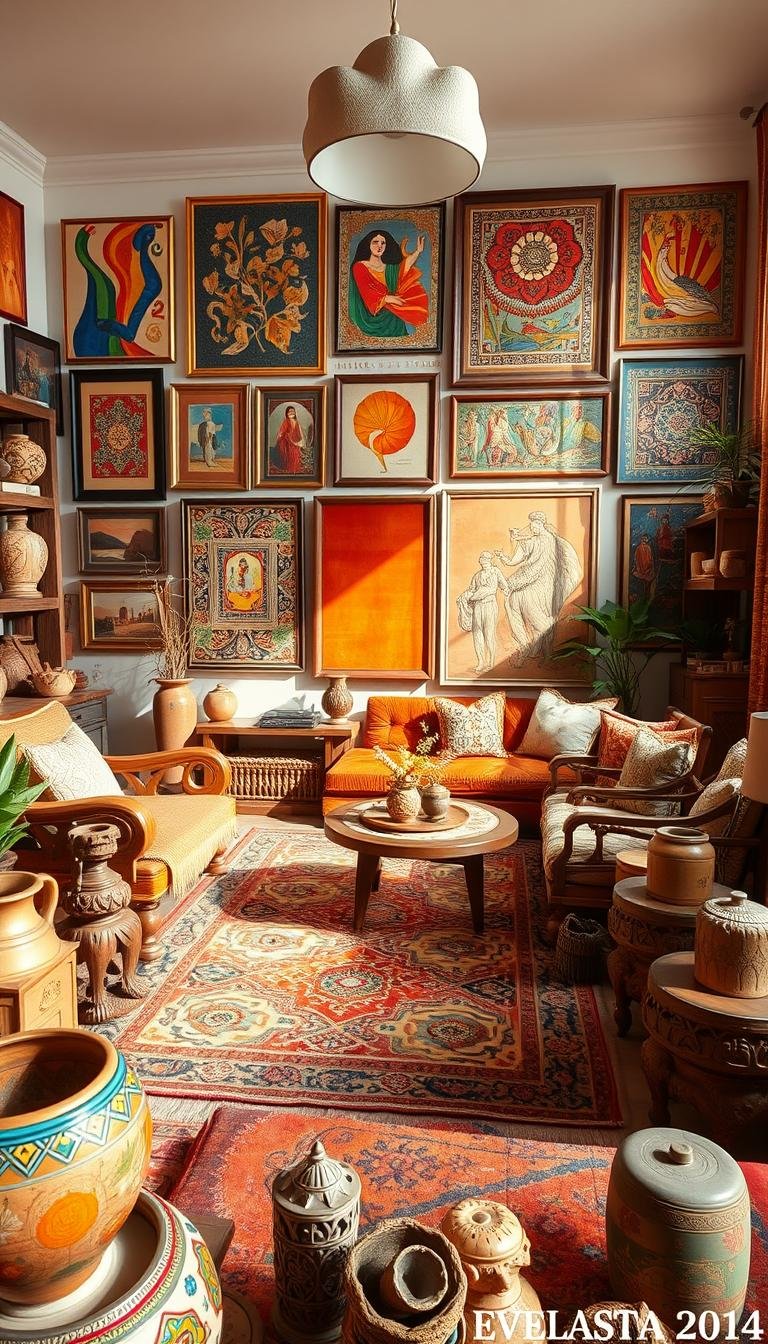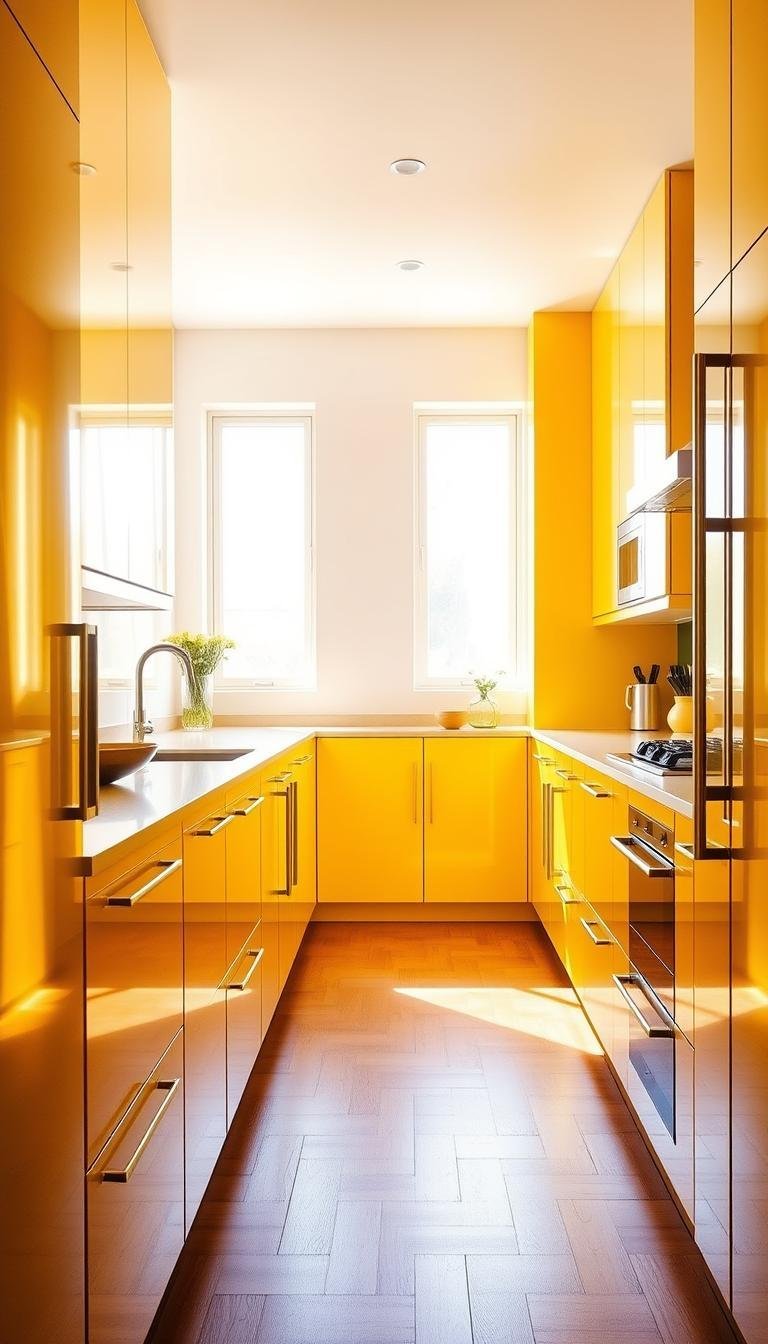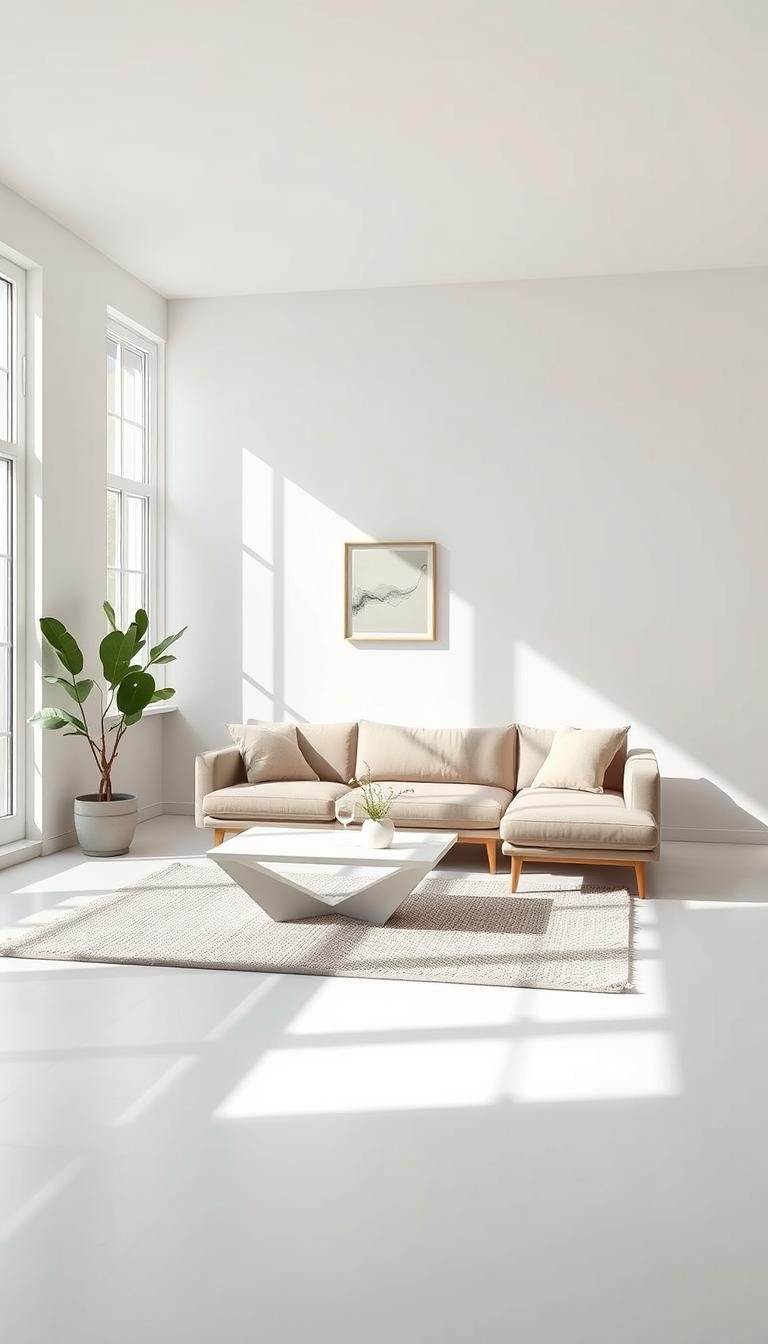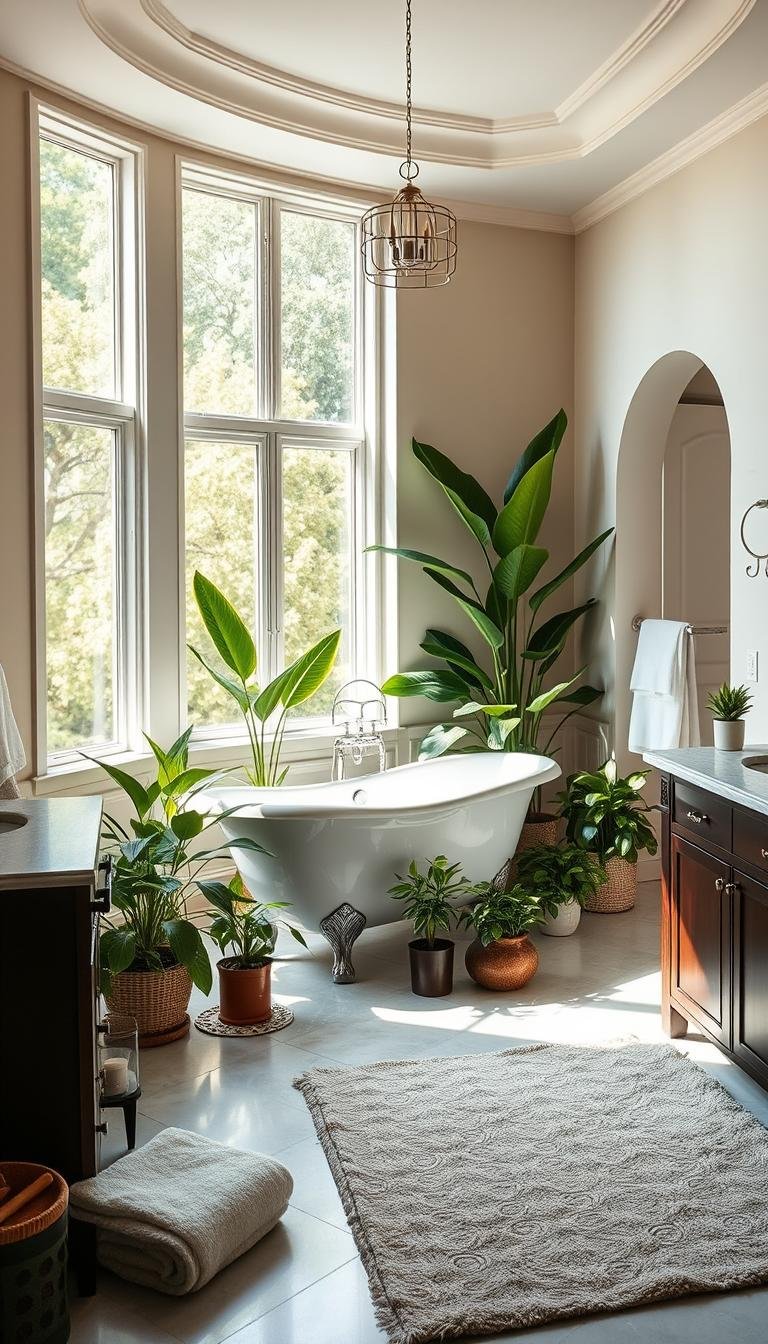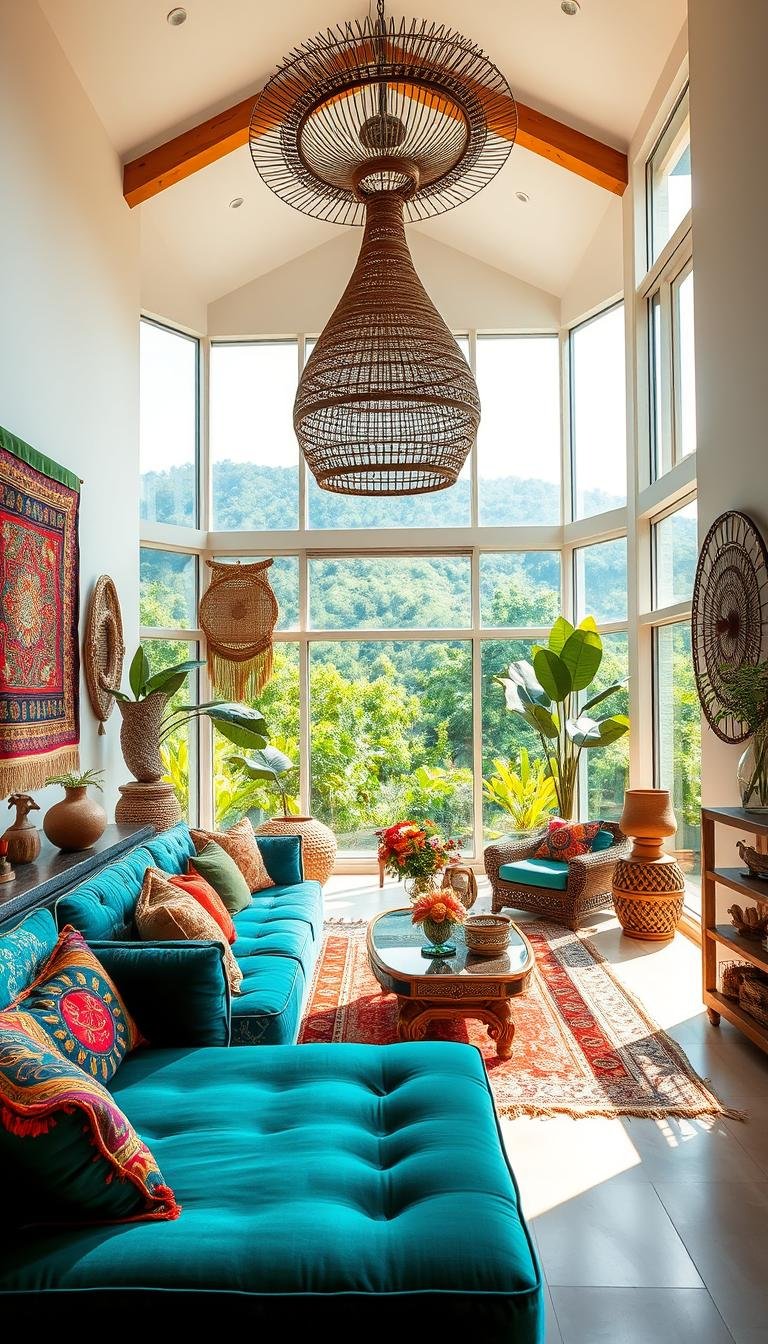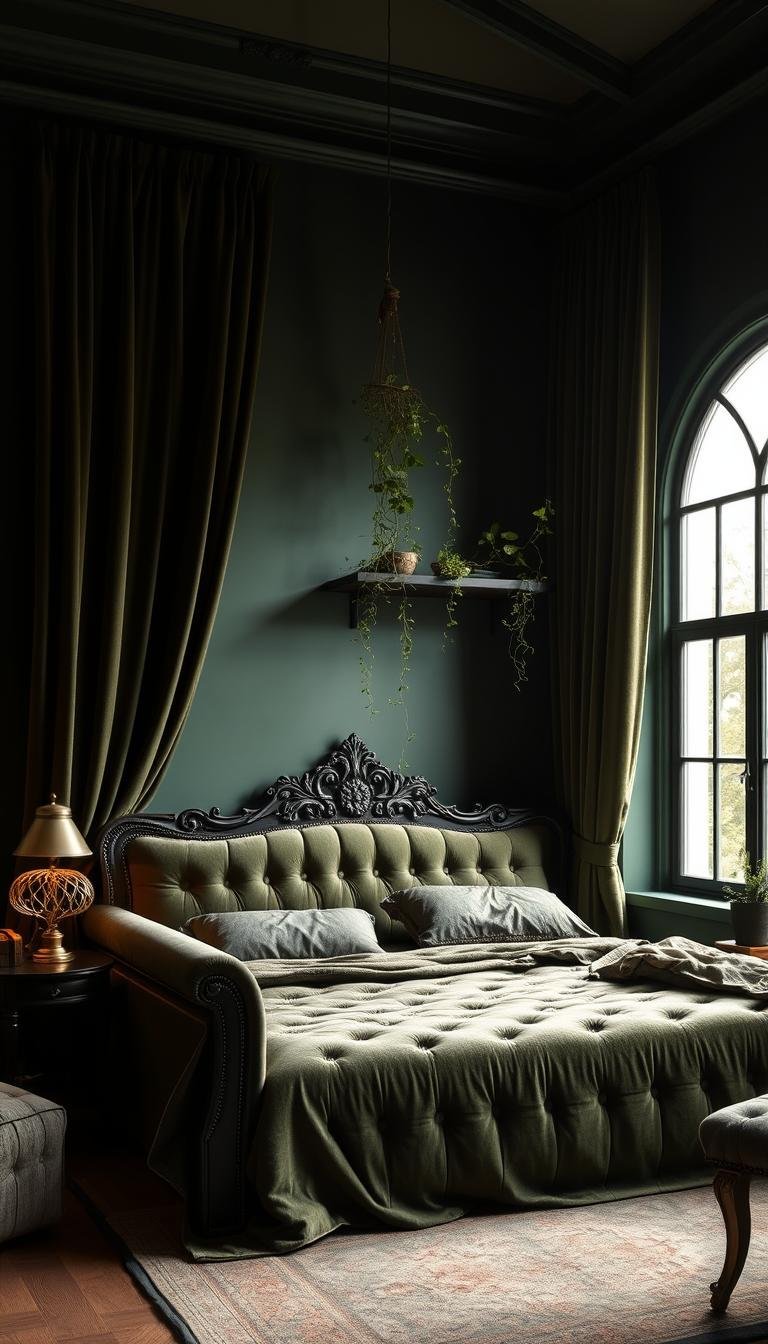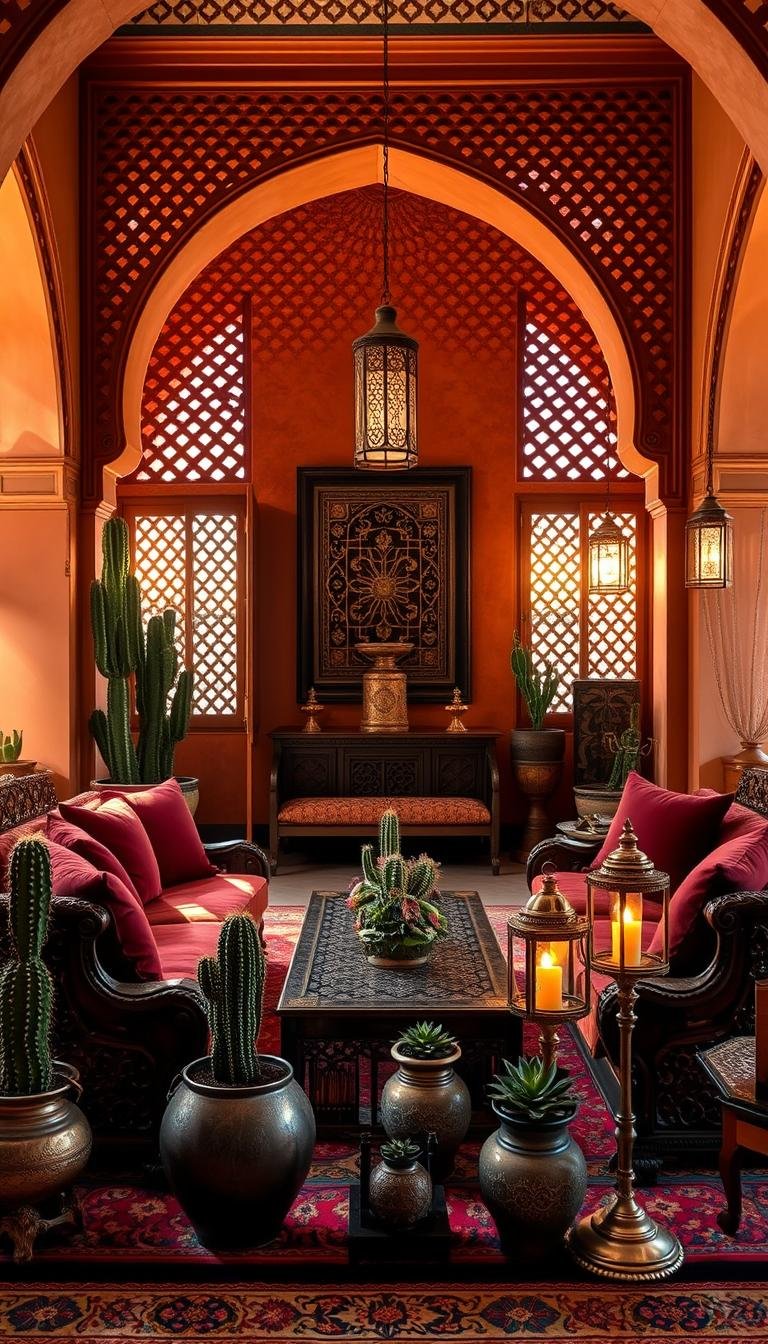This post may contain affiliate links. If you click and buy, we may earn a small commission at no extra cost to you. Learn more.
I love exploring the world of eclectic design. Here, cultural elements blend to create a unique space. As a fan of interior design, I’m excited to share this guide with you. It will help you mix styles, textures, and colors for a harmonious home decor.
Incorporating cultural elements into your decor is a growing trend. This guide will show you how to blend different cultural influences. You’ll learn to create a space that reflects your personality and taste.
By the end of this guide, you’ll know how to create a unique home decor style. It will showcase your individuality. Let’s start this journey together and explore the beauty of eclectic design!
Contents
- 1 The Essence of Global Home Decor Style
- 2 Principles of Ethical Cultural Mixing
- 3 Foundational Elements for Successful Global Mixing
- 4 Scandinavian Design: The Perfect Neutral Partner
- 5 Asian-Inspired Elements: Balance and Tranquility
- 6 Mediterranean and Middle Eastern Richness
- 7 African Design Elements: Texture and Artistry
- 8 Latin American and Mexican Vibrant Touches
- 9 Room-by-Room Global Styling Strategies
The Essence of Global Home Decor Style
The essence of Global Home Decor Style is blending different cultural elements into one story. It’s not just about looks; it’s about making a space that shows who you are and where you’ve been. By using pieces from various cultures, you can stir emotions and connect with your heritage.
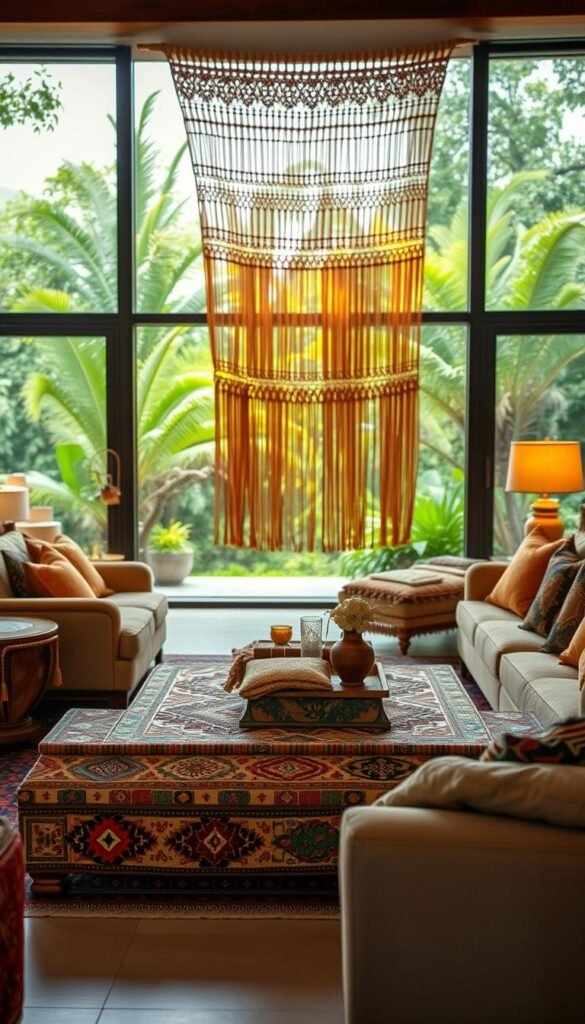
What Defines Global Eclectic Design
Global Eclectic Design mixes different cultural elements in a unique way. It combines vintage Moroccan tiles with Indian fabrics and Scandinavian furniture. The goal is to find a balance among these styles.
- A blend of traditional and modern pieces
- Incorporation of cultural artifacts and textiles
- A mix of bold colors and neutral backgrounds
The Cultural Storytelling Power of Mixed Decor
Mixed decor tells a story that’s both personal and universal. It combines elements from different cultures to reflect your travels, heritage, and style. Studies show it can evoke emotions and connect you to your heritage.
For example, a vintage Chinese vase can spark conversations. It shares stories of your family’s history and cultural traditions.
Principles of Ethical Cultural Mixing
Mixing cultures in home design can make a space truly unique and personal. But, it’s important to do it thoughtfully. We must know the difference between showing respect and taking something without permission.
Appreciation vs. Appropriation in Home Design
Appreciation means understanding and valuing something from another culture. Appropriation is taking something without giving credit or understanding. For example, using an African pattern in decor can show appreciation if we know its cultural value.
But, using the same pattern without knowing its origins is seen as appropriation. Experts say that cultural appropriation in design can be hurtful and insensitive. This shows we need to be careful and informed.
Honoring Cultural Context and History
To respect the cultural background of our home decor, we must learn about its origins. This means researching the history and meaning behind each piece. For instance, when adding Asian motifs, knowing their symbolic meanings is key.
This way, we create a space that celebrates diversity and respects heritage. It’s about more than just mixing cultures; it’s about doing it with respect and understanding.
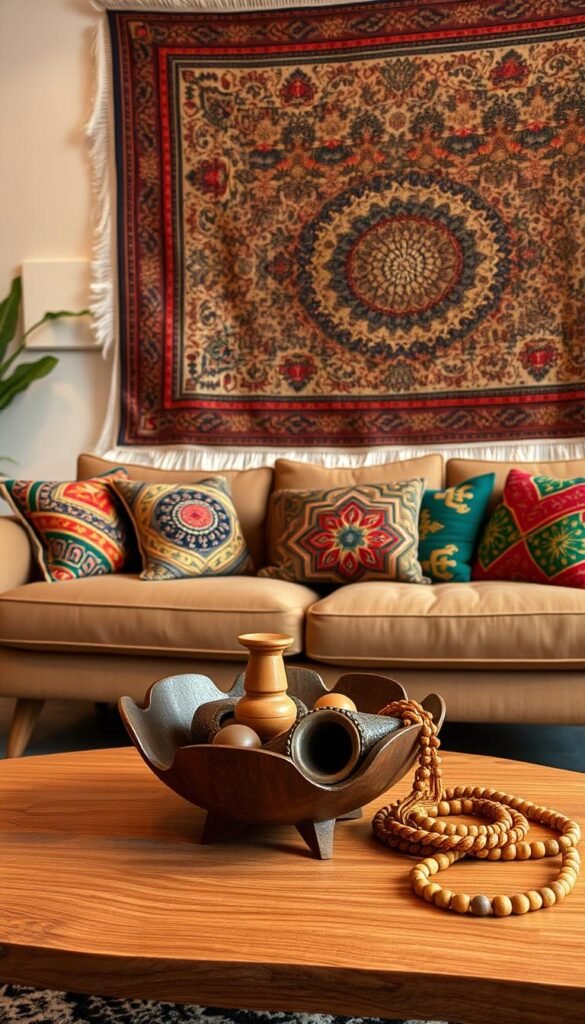
Foundational Elements for Successful Global Mixing
Global mixing needs a solid foundation for harmony and cultural richness. Understanding key elements is essential.
Creating a Neutral Base Canvas
A neutral base is key for mixing cultures. Experts say a neutral background lets diverse pieces stand out. Use soft colors on walls and floors and furniture with simple designs.
This creates a clean space for your global mixing.
Color Theory for Cross-Cultural Design
Color theory is vital in global mixing. Different cultures see colors differently. Choose core colors that work well together.
Follow the 60-30-10 rule: 60% of a main color, 30% of a secondary, and 10% of an accent. This balances your space.
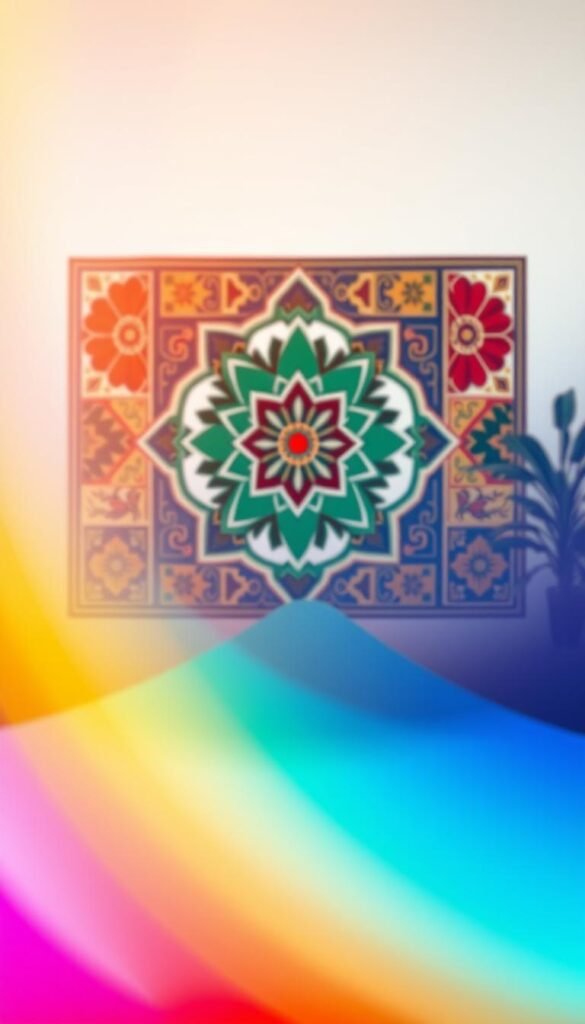
Texture and Material Harmony
Mixing textures and materials adds depth to your space. Combine smooth and rough textures thoughtfully. Think about how materials feel and look.
This creates a welcoming space that celebrates global diversity.
With a neutral base, color theory, and texture harmony, you’ll make a beautiful global space. It will show off your personal style.
Scandinavian design is known for its simplicity and usefulness. It’s a great choice for mixing with different styles, making your space feel balanced and peaceful.
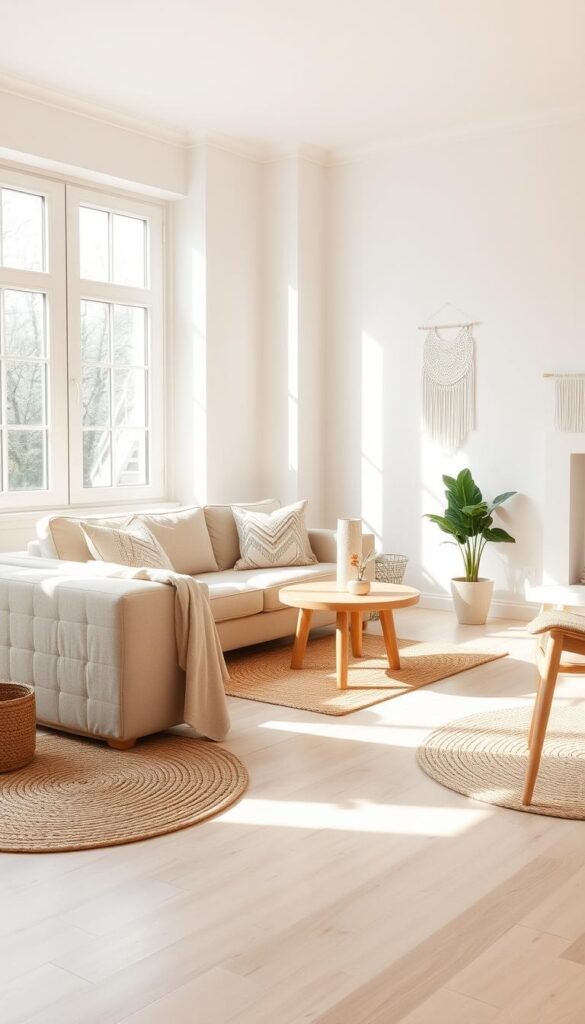
Key Nordic Design Elements Worth Incorporating
Nordic design has some key features that work well as a neutral base. These include:
- Minimalist silhouettes and clean lines
- Light woods such as oak and pine
- Neutral color palette with an emphasis on whites and grays
- Functional furniture with a focus on comfort
Adding these elements can make your home feel calm and inviting. It’s perfect for blending with other styles.
Scandinavian design pieces can enhance other cultural elements, adding elegance to your decor. For example, a minimalist Scandinavian sofa looks great with bold African or Indian patterns.
It’s all about finding the right balance. Use Scandinavian design as a base and add colorful pieces from other cultures. This way, you can create a space that’s both globally inspired and uniquely yours.
The result is a space that feels both globally inspired and intimately yours.
Asian-Inspired Elements: Balance and Tranquility
Adding Asian-inspired elements to your home can bring balance and tranquility. Asia’s diverse design traditions offer many ways to make your space serene and harmonious.
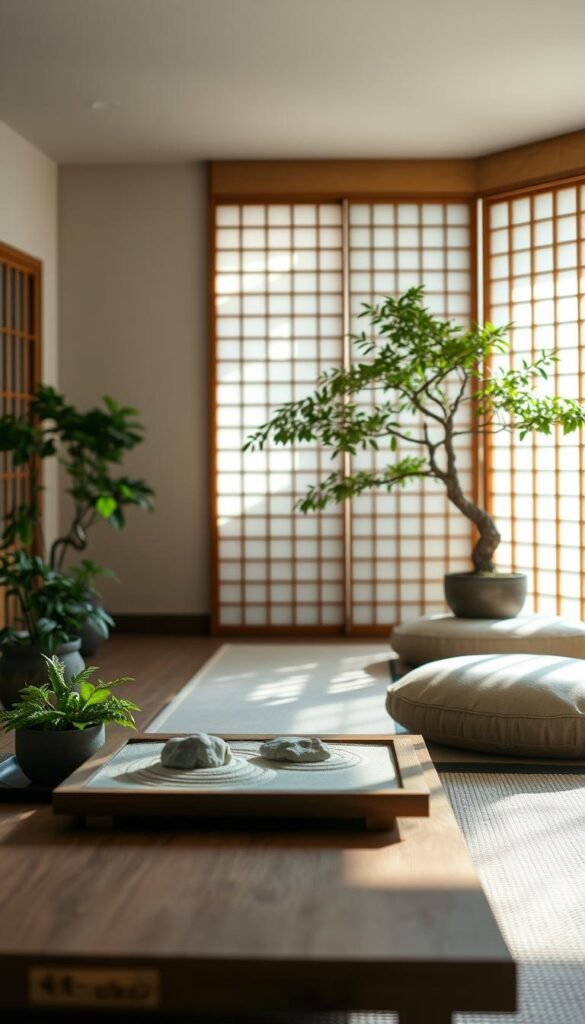
Minimalist Zen
Japanese minimalism focuses on simplicity and removing clutter. Using natural materials like wood and bamboo, and a neutral color scheme, creates a calm atmosphere. This approach celebrates the beauty of simplicity.
Chinese Elegance
Chinese design combines traditional and modern elements. It includes detailed hand-carved motifs and symbolic colors like red and gold. These add depth and cultural richness to your home, making it elegant and meaningful.
Tropical Oasis
Southeast Asian tropical elements, like bright colors and lush textiles, turn your home into a tropical oasis. Adding natural fibers and handicrafts from this region brings warmth and interest. These elements make your space cozy and inviting, like a retreat.
By mixing these Asian-inspired elements, you can create a balanced and peaceful home. It will be both tranquil and visually appealing.
Mediterranean and Middle Eastern Richness
The Mediterranean and Middle Eastern regions are famous for their rich culture. This is seen in their vibrant textiles, detailed patterns, and warm colors. These elements make a room more interesting and tell stories of the region’s history and traditions.
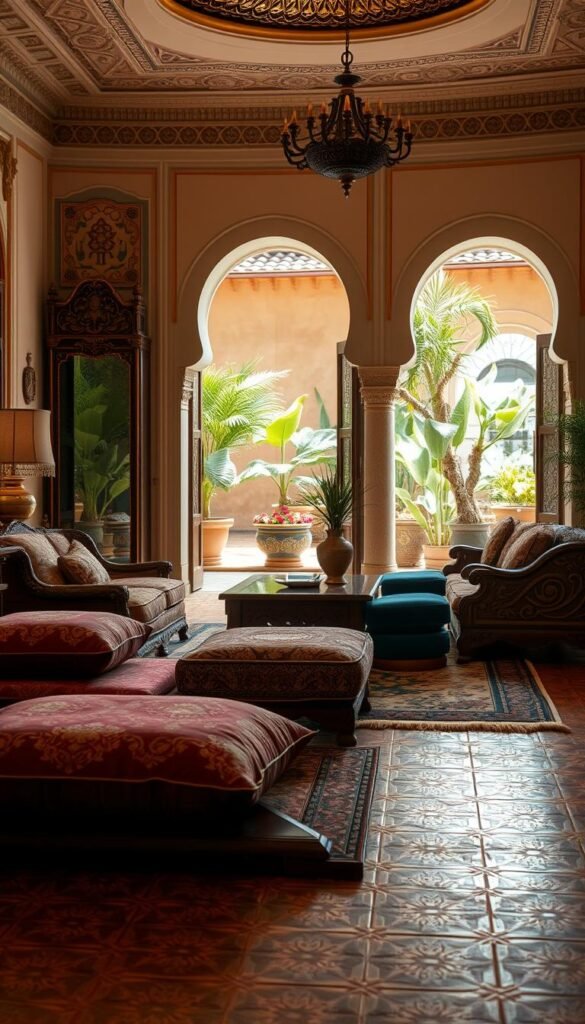
Moroccan Patterns, Textiles, and Architectural Details
Moroccan design is known for its detailed patterns, colorful textiles, and unique architectural features. Geometric patterns and zellij tiles can make any room look elegant. Adding Moroccan elements like colorful tiles, patterned rugs, and ornate metalwork can make a space both beautiful and culturally rich.
Mediterranean Colors and Natural Materials
The Mediterranean is known for its warm, earthy tones and natural materials. Colors like earthy reds, sunny yellows, and calming blues remind us of the Mediterranean. Using materials like terracotta, limestone, and wood adds warmth and makes a room cozy and inviting.
Turkish and Persian Rug Integration
Turkish and Persian rugs are famous for their beauty and skill. These rugs can make any room look luxurious and sophisticated. Adding a Turkish or Persian rug to your decor can help bring different design elements together, creating a space that feels cohesive and harmonious.
By carefully adding these Mediterranean and Middle Eastern design elements, you can make a home that is not only beautiful but also full of cultural heritage and stories.
African Design Elements: Texture and Artistry
I love the vibrant textures and artistry of African design. It’s exciting to share how you can bring these elements into your home. African cultures are known for their rich textile traditions and use of natural materials. These offer a wealth of design inspiration that can make any space more interesting.
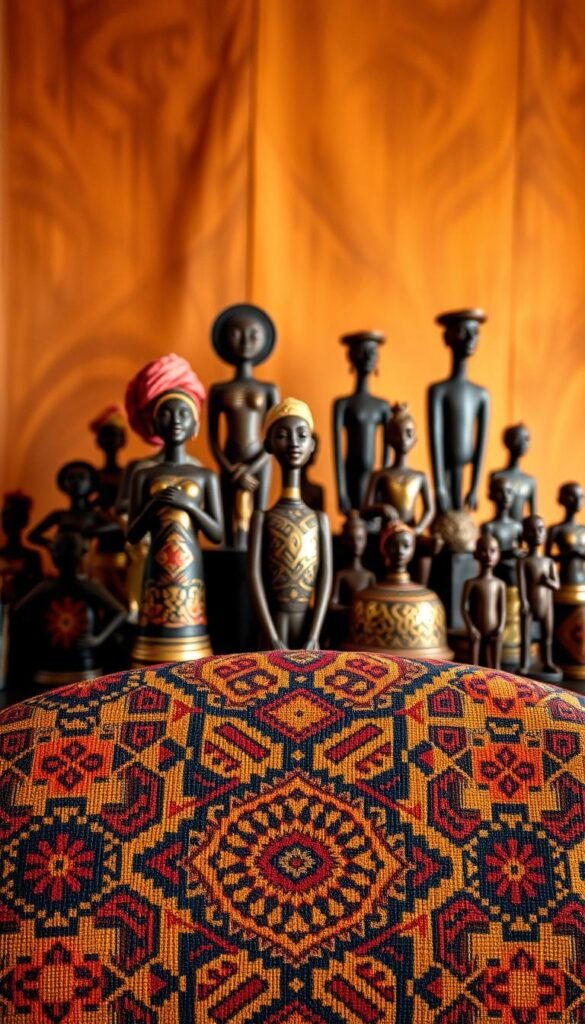
Tribal Patterns and Their Modern Applications
Tribal patterns are a key part of African design. They feature bold colors and detailed motifs that can add energy to your decor. You can use traditional textiles like Ankara or Kitenge prints, or modern versions on rugs, throw pillows, or wall art. The trick is to mix these bold patterns with simpler elements to keep the space balanced.
For instance, combining a vibrant African print fabric with a plain white sofa creates a striking contrast. “African patterns are not just beautiful; they tell stories and carry cultural significance,” says a renowned designer. You can also use these patterns to highlight a room, like an accent wall or a standout piece of furniture.
Natural Materials and Sculptural Statements
African design also values natural materials, like the warmth of wood and the earthiness of woven fibers. Adding natural materials like jute, sisal, or woven baskets can bring texture and warmth to your space. Sculptural pieces made from natural materials or metalwork can also serve as stunning statement pieces, showing off African craftsmanship.
To use these elements well, mix natural materials with modern shapes or use them as accent pieces. For example, a beautifully crafted wooden mask or a metal sculpture can be a unique conversation piece in your living room.
Latin American and Mexican Vibrant Touches
I’m excited to share the beauty of Latin American and Mexican styles. They can make your living space lively and full of energy. These cultures are known for their rich heritage and vibrant expressions. They are perfect for adding a bold and unique touch to your home decor.
Color Stories from South of the Border
The color palette from Latin America and Mexico is truly captivating. It features warm terracottas, deep blues, and vibrant yellows. These colors can make your home bold and inviting.
You can use these hues for accent walls, vibrant textiles, or colorful ceramics. They add depth and visual interest to your rooms.
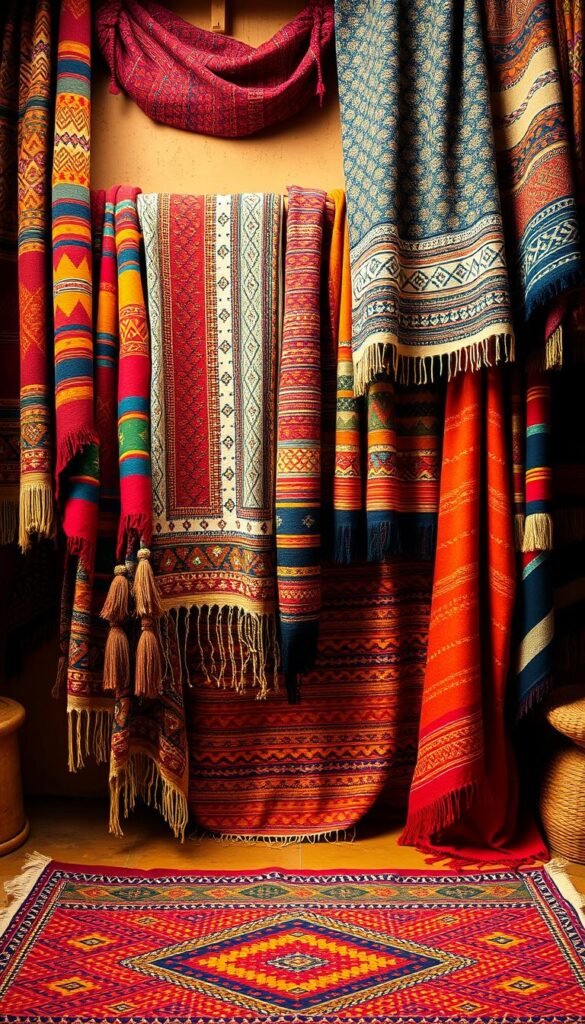
Artisanal Crafts and Folk Art Integration
Latin American and Mexican cultures are also celebrated for their artisanal crafts and folk art. These can add a unique, personal touch to your home. Consider adding handmade items like intricately woven baskets, colorful pottery, or traditional textiles to your decor.
These pieces bring warmth and character to your space. They also tell a story of cultural heritage and craftsmanship.
To integrate these elements effectively, use them as statement pieces or mix them with minimalist decor. For example, a vibrant Mexican blanket can be used as a throw to add color to a neutral sofa. Or, a beautifully crafted Latin American vase can be displayed as a centerpiece. It adds elegance and cultural flair to your dining table.
Room-by-Room Global Styling Strategies
I love bringing global styling into every room of the home, and it’s easier than you think! Design experts agree that a thoughtful, room-by-room approach is essential for achieving a cohesive global style. Let’s start with the living room, where you can create a statement piece by combining a Scandinavian sofa with a Moroccan pouf and a vibrant Latin American textile.
When it comes to the bedroom, Asian-inspired elements can bring balance and tranquility. Try pairing a Japanese minimalist bed frame with a colorful Indian rug and some African tribal patterns on the bedding. In the kitchen, Mediterranean and Middle Eastern richness can be achieved with warm colors, natural materials, and Turkish or Persian rugs.
To successfully implement global styling room-by-room, focus on creating a neutral base canvas, then add cultural elements that reflect your personality and style. By incorporating different design strategies, you can create a beautiful and inviting space that feels cohesive and harmonious throughout.
To bring you cozy inspiration more efficiently, we sometimes use AI to assist in content creation — but every word and idea is carefully shaped by our team. See our AI Disclosure for more info.

